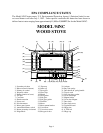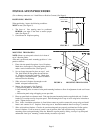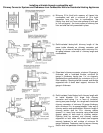
POSSIBLE TOOLS NEEDED FOR INSTALLATION
If you decide to install your own stove, there are several hand tools you may need to do the job.
If you do not already have them, they are readily available at most hardware stores.
Caulking gun
Large adjustable wrench (may not be needed)
Drop cloths or newspapers
Vacuum cleaner or whisk broom
Flashlight
1 tube of RTV silicone, Code 103 or 106, or high temperature rubber cement rated between 450
o
F- 600
o
F
7/32" drill bit and drill
Socket/Ratchet Set
INSTALLATION PREPARATION
Fireplace:
1. Locate furniture and other materials away from front of fireplace to allow free access to
fireplace.
2. Cover hearth and adjacent floor areas with a drop cloths to protect from soiling or marring
surface.
3. Remove existing fireplace damper plate.
4. Thoroughly clean fireplace of ashes and soot.
5. Check chimney and smoke chamber for excessive buildup of creosote or soot. Also, check
for obstructions, such as bird’s nests. If chimney is excessively dirty, clean it or have
someone clean it professionally BEFORE installing or using room heater.
6. If fireplace has an ash dump or outside air provision, these must be sealed off with metal or
tightly packed non-combustible insulation to prevent cold air from entering fireplace
chamber.
MASONRY INSERT INSTALLATION
INSTALLATION OPTIONS
This unit (appliance) may be installed into an all masonry fireplace, built in accordance with
Uniform Building Code and National Fire Protection Association (NFPA 211).
NOTE: Check with local building officials for any permits required for installation of this unit
and notify your insurance company before proceeding with installation
Improperly drawing fireplaces, oversize flue liners or to meet codes in certain areas it is recom-
mended that one of the flowing procedures be followed.
A. A Chimney Connector be installed from appliance flue exit through damper with an air
-tight face seal. See option (A) Figure 2, page 7.
B. A listed Direct Connect be installed from appliance flue exit through damper into first
section of flue liner with an air-tight seal. See option (B) Figure 3, page 7.
C. A Positive Connect be installed from appliance flue exit continuing up through entire
chimney and exiting at top of the chimney. See option (C) Figure 4, page 7.
Page 6


















